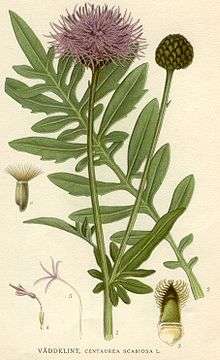Centaurea scabiosa
| Centaurea scabiosa | |
|---|---|
 | |
| Scientific classification | |
| Kingdom: | Plantae |
| (unranked): | Angiosperms |
| (unranked): | Eudicots |
| (unranked): | Asterids |
| Order: | Asterales |
| Family: | Asteraceae |
| Tribe: | Cynareae |
| Genus: | Centaurea |
| Species: | C. scabiosa |
| Binomial name | |
| Centaurea scabiosa L. | |
Centaurea scabiosa or Greater Knapweed is a perennial plant of the genus Centaurea. It is native to Europe and bears purple flower heads.
Greater knapweed is found growing in dry grasslands, hedgerows and cliffs on lime-rich soil. Upright branched stems terminate in single thistle-like flowerheads, each having an outer ring of extended, purple-pink 'ragged' bracts which form a crown around the central flowers. The plant has deeply dissected leaves which form a clump at the base.
This species is very valuable to bees. It is also a magnet for many species of butterfly. Among them is the Marbled White.
This is the only known foodplant for caterpillars of the Coleophoridae case-bearer moth Coleophora didymella. Centaurea scabiosa has been used in traditional herbal healing as either a vulnerary or an emollient.
The plant is sometimes confused with Devils-bit Scabious, however the leaves on this plant are arranged alternately, whereas in Devils-bit they are opposite.[1]
Images
References
- ↑ Rose, Francis (1981). The Wild Flower Key. Frederick Warne & Co. pp. 385–387. ISBN 0-7232-2419-6.
- The Wild Flower Key British Isles-N.W. Europe by Francis Rose, page 385
| Wikimedia Commons has media related to Centaurea scabiosa. |



